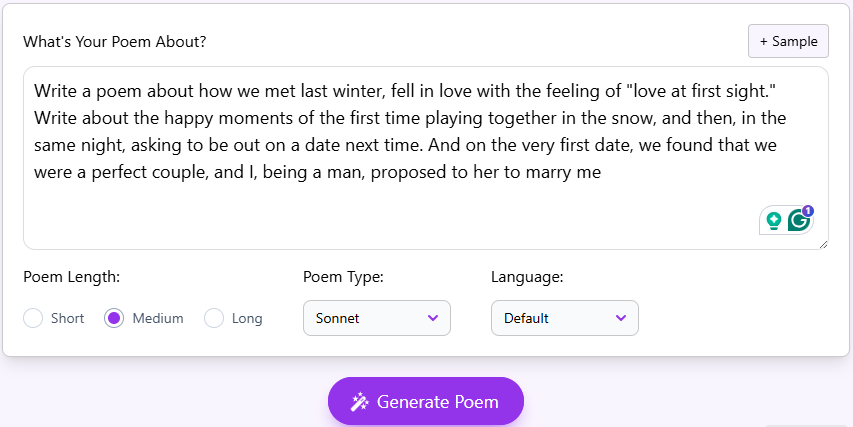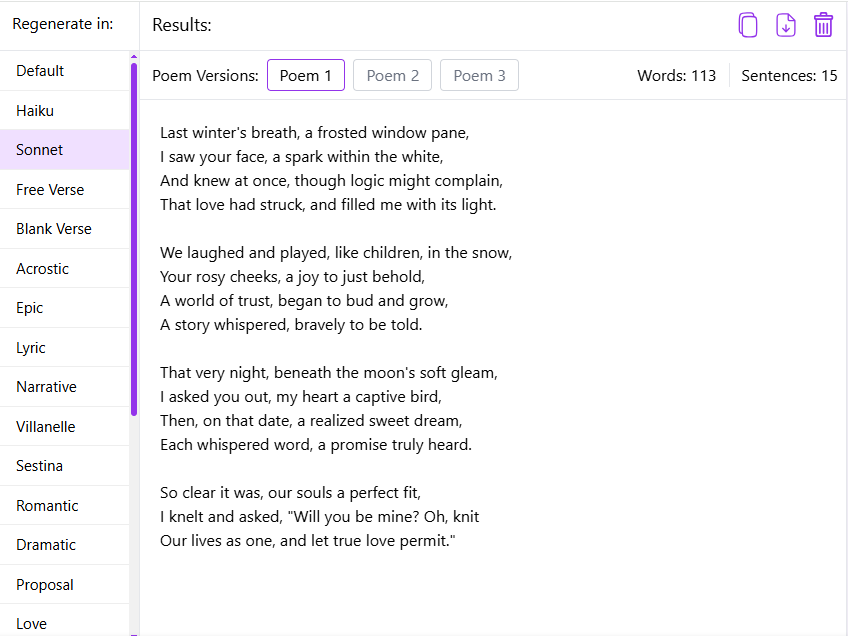Poetry serves as a timeless medium for connecting human emotions and sensations with language.
It is an art form in which creativity flourishes; authors convey their imagination to the reader’s mind through the use of carefully chosen words that resonate with the writer’s emotions.
Poetry has consistently been regarded as one of the human arts that requires imagery, distinctive thoughts, and a unique writing style.
With the rise of artificial intelligence, a question began to surface: Can a machine replicate human intelligence and compose poetry?
Well! This issue was addressed with the arrival of AI poem generators. These AI tools are becoming more comprehensive with time.
But to understand how an AI poem generator can mimic human writing and generate poetry with precision, it is essential to understand its working mechanism.

Extracting Facts About How an AI Poem Generator Works
An AI poem generator can generate poetry by following the instructions given by the users. A poem generator cannot experience emotions and feelings like humans, but can mimic human writing styles, rhythm, and patterns of poetry that have been used for centuries.
This capability has been made possible through the training of these AI models on extensive collections of poetic texts, allowing them to understand the mechanics of poem verses.
1. Training Data Role
The key component that enables an AI poem generator to operate is its training data, which comprises an extensive collection of poem types, including Haiku, limerick, free verse, sonnet, ballad, and many others.
With time and continuous analysis of this data, the modern AI poetry tools have become able to understand the following components of the poetry:
- How words associate with one another, for example, the moon is mostly associated with beauty, love, and romance.
- What rhythmic patterns can be used, like focusing on syllable count, stressed, and unstressed syllables.
- It understands how to use rhyme schemes to arrange stanzas accordingly.
- It learns about the specific use of words to express emotions and situations.
2. Work On Prompts
All AI poetry tools can produce outcomes by intelligently processing the prompts submitted by users. Being a user, you can instruct these tools to write a poem by giving details about the topic, tone, theme, mood, or type.
Here is the step-by-step working process of these AI poetry generators:
- You provide the input in the prompt box
- The tool analyzes and understands the context and the style that you want
- It produces word-for-word and line-by-line verses that match your desired results
To show you how it works, we’ll use the AI poem generator by AIPoemGenerator.io by providing a detailed prompt in the generator’s input box and observe what poem results it can generate.

After entering the prompt into the input and selecting the poem’s length, type, and language, AIPoemGenerator.io provides impressive poem results.

It followed the context, imagery, and every word given in the prompt, and the best part is that it generates three versions of poetry for the same input.
3. Technology That Helps AI Tools To Generate Unique Poetry
While the operation of the AI poem writers might seem magical, it’s a purely technical process. Most of these tools utilize deep learning models to comprehend and generate text.
They cannot think or feel like humans, but they can they can predict the next associated word that has already been used several times in history.
Also, these models memorize contexts that have been used for writing different types of lines.
This technique allows AI poetry generators to maintain the theme or tone of the tool. The majority of these tools operate on randomness, ensuring that the newly created poetry does not resemble or replicate any previous version.
4. Following Rules But Inputting Creativity
Different forms of poetry have strict rules, such as Villanelles’ repeating lines and the use of syllables in a Haiku. The AI poetry generators are trained to follow these strict rules, and still, they come up with all-new material.
Consider finding a tool that understands the need to follow the rules but creatively works on them and provides you with amazing results without compromising on the quality of the text.
5. The Role Of Human Touch
Regardless of whether it is poetry or prose, the integration of human skills with AI tools is inevitable.
The majority of AI tools operate based on established patterns, producing predictable text that may lack relatability, emotional depth, and overall effectiveness.
These tools are capable of imitating human language and emotions, but they cannot modify the text in the same way that humans can. Therefore, after receiving results from AI, it is essential to review the entire content and make necessary adjustments.
Conclusion
An AI poem generator can provide expected results by using its massive database of poetry, a newly updated algorithm, and your detailed input. These tools can generate inspiring and emotional poems by understanding human expressions and emotions.

Founder Dinis Guarda
IntelligentHQ Your New Business Network.
IntelligentHQ is a Business network and an expert source for finance, capital markets and intelligence for thousands of global business professionals, startups, and companies.
We exist at the point of intersection between technology, social media, finance and innovation.
IntelligentHQ leverages innovation and scale of social digital technology, analytics, news, and distribution to create an unparalleled, full digital medium and social business networks spectrum.
IntelligentHQ is working hard, to become a trusted, and indispensable source of business news and analytics, within financial services and its associated supply chains and ecosystems










